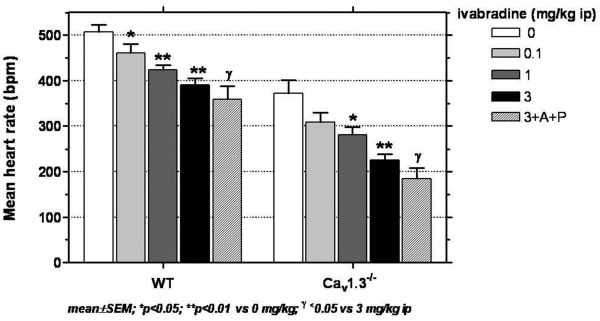The If and the Cav1.3-mediated L-type Ca2+ currents play important roles in the genesis of cardiac automaticity and heart rate (HR). The differential role of f- and Cav1.3- channels in pacemaking is not completely elucidated. More importantly, it is not known if automaticity can persist after inhibition and/or inactivation of both f- and Cav1.3 channels. The effects of If inhibition by ivabradine (IVA), the first specific and selective If sinus node inhibitor, were investigated on ECG parameters using telemetry in wild-type (WT; n=7) and Cav1.3 knockout (Cav1.3-/-; n=7) mice, spontaneously bradycardic. IVA was administrated once intra-peritoneally (ip bolus) from 0.1 up to 6 mg/kg. In WT and Cav1.3-/- mice, IVA dose-dependently reduced the mean HR (Fig.) without affecting the QRS complex. At 3 mg/kg, mean HR reduction was –23 and –39% in WT and Cav1.3-/- (p<0.01), respectively. Saturation of IVA effect on HR was observed between 3 and 6 mg/kg, suggesting complete and specific in vivo inhibition of If at these doses. In Cav1.3-/- mice, intrinsic HR measurement after injection of atropine (0.5 mg/kg ip) and propranolol (1 mg/kg ip) (A+P) to block autonomic input, showed that If inhibition by IVA at 3 mg/kg ip did not stop pacemaking but only lowered intrinsic HR from 226±34 bpm at 3 mg/kg to 184±24 bpm with A+P at the same dose (p<0.05). In conclusion, f- and Cav1.3 channels control the mean HR. If inhibition lowered both the mean and maximal HR. Contrary to f-channels, Cav1.3 channels do not reduce the maximal HR, but stabilize HR. Most importantly, both normal and intrinsic pacemaker activity can persist in the absence of Cav1.3 channels even after partial inhibition of HCN channels. These observations indicate that multiple mechanisms contribute to cardiac automaticity and, thus to the safety of HR reducing agents such as ivabradine.
University of Manchester (2007) Proc Physiol Soc 8, PC41
Poster Communications: A differential role for f- and Cav1.3-channels in the genesis and regulation of heart rate: physiological effects of If inhibition by ivabradine in mice lacking L-type Cav1.3 Ca2+ channels
L. Marger1, M. Bouly2, H. Aptel1, A. Leoni4, A. Cohen-Solhal1, J. Striessnig3, F. Mahlberg-Gaudin2, J. Nargeot1, M. E. Mangoni1
1. Physiology, Institute of Functional Genomics, CNRS UMR5203, Montpellier, Hérault, France. 2. Institut de Recherche Internationales Servier (IRIS), Courbevoie, France. 3. Abteilung Pharmakologie und Toxikologie Institut fur Pharmazie und Centrum fur Molekulare Biowissenschaften, Universitat Innsbruck, Innsbruck, Austria. 4. Institut du Thorax, Inserm U533, Nantes, France.
View other abstracts by:
Where applicable, experiments conform with Society ethical requirements.

